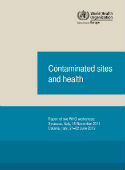Contaminated sites and health. Report of two WHO workshops: Syracuse, Italy, 18 November 2011; Catania, Italy, 21–22 June 2012

Download
2013
In Europe, earlier industrialization and poor environmental management practices have left a legacy of thousands of contaminated sites. Past and current activities can cause local and diffuse accumulation of environmental stressors to an extent that might threaten human health and the environment, by altering air quality, hampering soil functions, and polluting groundwater and surface water.
The WHO European Centre for Environment and Health organized two technical meetings − which included representatives of environmental and public health agencies (at the national and international levels) and research experts − to explore priorities, interests and needs and to review the state of the art, the current methodological options, and knowledge gaps in the domain of contaminated sites and health.
The assessment of the possible health impact of contaminated sites is a challenging exercise, especially in the case of industrially contaminated sites with ongoing multiple industrial activities and involving multiple human exposures. Notwithstanding these complexities, a variety of methods and tools for health impact assessment have been developed and applied to study contaminated sites, and a broad range of resources is available; these must be carefully selected and applied, depending on the needs, objectives and local feasibility.
Available assessments suggest that contaminated sites are an important public health issue at the national and international levels. Priority topics and goals for collaborative work on contaminated sites and health were identified at the two meetings.



